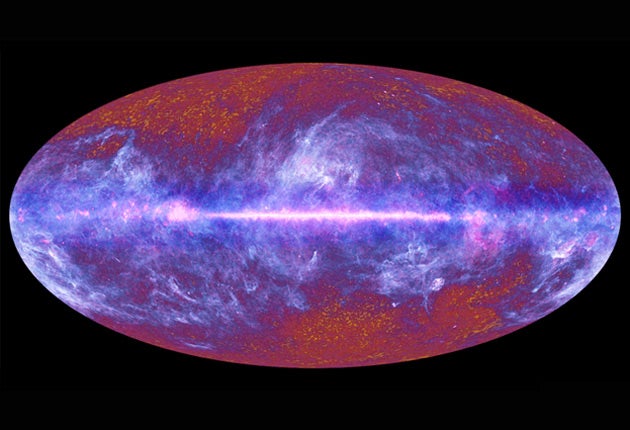'Afterglow' of Big Bang captured by satellite

Your support helps us to tell the story
From reproductive rights to climate change to Big Tech, The Independent is on the ground when the story is developing. Whether it's investigating the financials of Elon Musk's pro-Trump PAC or producing our latest documentary, 'The A Word', which shines a light on the American women fighting for reproductive rights, we know how important it is to parse out the facts from the messaging.
At such a critical moment in US history, we need reporters on the ground. Your donation allows us to keep sending journalists to speak to both sides of the story.
The Independent is trusted by Americans across the entire political spectrum. And unlike many other quality news outlets, we choose not to lock Americans out of our reporting and analysis with paywalls. We believe quality journalism should be available to everyone, paid for by those who can afford it.
Your support makes all the difference.It's sometimes known as the "afterglow of creation" because it was the first light to be produced when matter began to form following the Big Bang some 13.7 billion years ago.
Now scientists are close to producing the best-ever image of this fossilised relic from the dawn of time.
Yesterday, the European Space Agency released the first image of the entire sky taken by the Planck satellite which was launched last year with the aim of mapping the cosmic microwave background radiation – the afterglow of creation – in every part of the known Universe. The image was produced following the satellite's first full-scan of the entire sky. It will be used to produce the most detailed and precise picture of the background radiation left behind by the fireball of the Big Bang.
In this image, we are seeing the Universe from the centre of the picture looking out. The microwave background radiation is the yellow blotches of light in the further reaches of the Universe in the upper and lower regions of the map. Radiation from our own galaxy, the Milky Way, shows up as the streak of white light running through the middle, while the blue and red regions are the radiation given off by the dust and hot gas of interstellar space.
The thin disc of white light from the Milky Way separates the northern sky at the top of the image from the southern sky below. This extraneous radiation which conceals the microwave radiation closest to our own place in the Universe will be digitally erased to produce the most detailed map of the microwave background radiation as seen with nine different bands or "colours" of the microwave light.
"Planck has 'painted' us its first spectacular picture of the Universe," said David Parker, director of space science and exploration at the UK Space Agency, which supports the British participants on the international research project. "This single image captures both our own cosmic backyard – the Milky Way galaxy that we live in – but also the subtle imprint of the Big Bang from which the whole Universe emerged," Dr Parker said.
Scientists first predicted the existence of the cosmic background radiation more than 60 years ago and it was first detected in the 1960s. Sixteen years ago, the Cobe satellite produced the first full-sky map of the radiation, showing that it must have derived from the Big Bang because it exists in every direction of the Universe that is scanned.
"It has taken 16 years of hard work by many scientists in Europe, the US and Canada to produce this new image of the early Universe. Planck is working brilliantly and we expect to learn a lot about the Big Bang and the creation of our Universe," said Professor George Efstathiou, the Planck Survey Scientist at Cambridge University.
The cosmic background radiation was released about 400,000 years after the Big Bang when the first atoms were beginning to form. Scientists believe that the "clumpiness" of the background radiation is actually the cosmic blueprint from which today's clusters of galaxies formed under the influence of gravity – a relic map of the Universe from the beginning of time.
Join our commenting forum
Join thought-provoking conversations, follow other Independent readers and see their replies
Comments